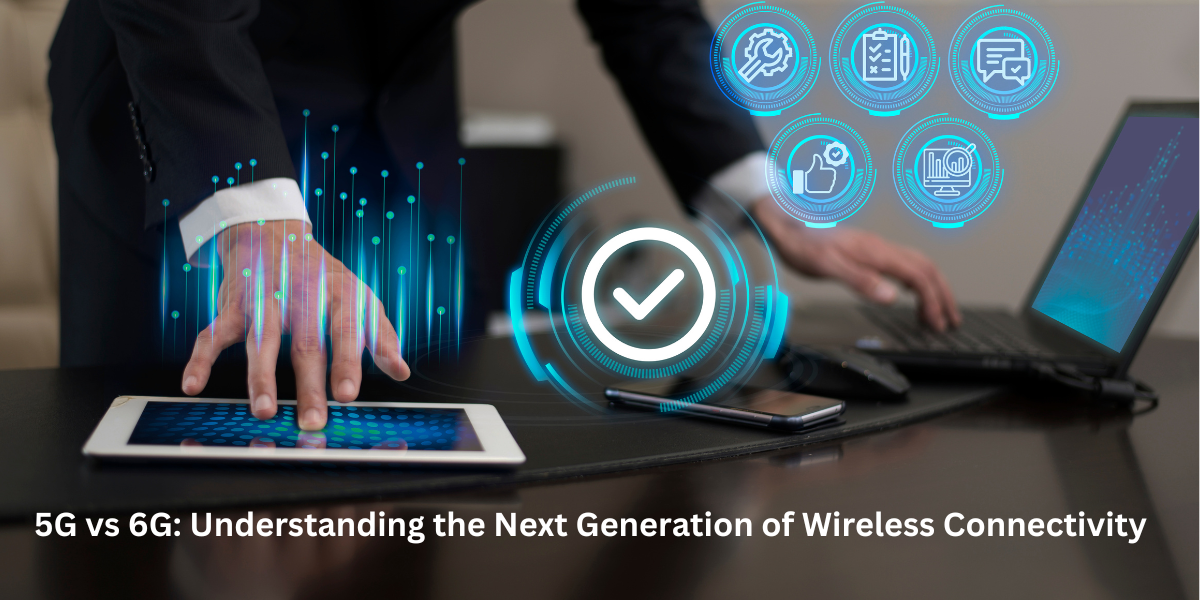The tech world is evolving quickly, and while 5G is still making its mark, there’s already talk of 6G. You may wonder, “How will 6G be different?” In this blog, we’ll explore how 6G will push wireless connectivity even further than 5G. Let’s dive into how these technologies compare and what they mean for our everyday lives.
1. Speed and Performance – Redefining Fast
5G introduced more incredible speed where we could download high definition movies within a few seconds and internet gaming was made possible. It is much more than a step up from 4G, providing internet speeds that can seem like the content is appearing in an instant. So, if you are excited about 5G, wait until you get a feel of 6G.
The sixth generation of the network is expected to provide a connection that is 5 to 100 times faster than the fifth generation. Consider engaging in a file-sharing process which may take several minutes, to be able to download a whole series in a blink of an eye. Traffic at peak rates of up to one terabit per second will be supported. This increment in speed is not only going to enhance the web-browsing and streaming experience but is also going to pave the way for some truly revolutionary technologies. Here, we can discuss virtual tourism or, for example, virtual reality, which actually makes one feel like teleported or provides virtually unlimited information to process with no delays whatsoever – that’s what the 6G performance is believed to redefine the meaning of “fast.”
2. Latency – The Need for Zero Delay
Latency is the delay between your action and the network’s response. In simple terms, it’s the lag that happens before something loads or reacts. With 5G, latency is as low as one millisecond, which makes things like video calls, online gaming, and smart applications almost instantaneous.
But 6G aims for practically zero latency, reducing this delay even more. This means controlling devices remotely without even a hint of delay, crucial for things like remote surgery or autonomous vehicles. Imagine a doctor performing surgery on a patient hundreds of miles away with real-time precision, or drones being controlled from the other side of the world with no delay. This reduction in latency will make everything you do online feel like it happens in real-time, which can significantly improve the user experience in countless applications.
3. Capacity – Connecting More Devices Than Ever
5G made it possible for more devices to connect simultaneously without impacting performance. It’s perfect for smart homes, cities, and millions of connected gadgets that need to work together smoothly. But as we step into the world of 6G, connectivity capacity is set to explode.
6G will take the idea of connected devices to a whole new level. Imagine a city filled with billions of sensors—traffic lights, smart vehicles, street cameras, and even wearables—all communicating seamlessly. 6G networks will be able to manage this vast influx of data, connecting everything without slowing down. The result will be cities that operate more intelligently, smoother functioning systems, and an even more connected lifestyle. Capacity isn’t just about connecting more devices; it’s about making those connections smarter and more responsive.
4. Applications – The Future of Possibilities
5G brought us innovations like smart cities, augmented reality, remote working, and self-driving cars. It’s revolutionizing the way we experience our world, making applications like virtual meetings and connected healthcare systems more reliable and accessible. However, with 6G, the boundaries of what we can do will expand exponentially.
6G will bring in applications that seem like science fiction today. Imagine stepping into a holographic meeting that feels just as real as an in-person gathering, or having wearables that continuously monitor your health and alert doctors in emergencies before you even notice the problem. Beyond smart cities, we’ll see truly intelligent environments that adapt in real-time to the needs of citizens, from responsive energy grids to personalized public services. These future applications will make 6G more than just faster internet—it’ll enable transformative experiences that change how we live, work, and play.
5. Artificial Intelligence Integration – Making Networks Smarter
5G has started integrating AI to manage networks, but 6G will take AI capabilities to a whole new level. AI will be deeply embedded within 6G networks, allowing them to adapt instantly to changing conditions and demands.
Imagine a network that learns your habits—like boosting connectivity when you’re in a virtual meeting or reducing energy usage when it knows you’re away. This AI-driven network will provide a smoother, more customized experience. With AI as a core component, 6G will also facilitate faster data processing, meaning less reliance on centralized data centers and more real-time solutions right at the edge of the network. This smarter, AI-powered connectivity will make our devices more intelligent and responsive than ever before.
6. Energy Efficiency – A Greener Future
5G already promises better energy efficiency compared to older networks, but 6G is expected to be even more environmentally friendly. As more devices connect to the internet, reducing energy consumption becomes crucial. 6G will focus on reducing the power needed for data transmission while delivering far superior capabilities.
This means our phones, wearables, and other gadgets will have longer battery lives, and the overall power needed for global data transmission will be lower. Sustainable connectivity is becoming more important, and 6G is set to provide a green boost, helping cut down on energy waste. It’s a win-win: more performance, less energy consumption, and a smaller impact on our planet.
7. Network Architecture – The Evolution Continues
5G uses advanced technologies like Massive MIMO (Multiple Input, Multiple Output), which allows multiple devices to use the same cell without interference. It’s part of what gives 5G its impressive capacity and speed. But 6G’s architecture will be even more advanced, incorporating intelligent surfaces, terahertz frequency bands, and more.
6G will use higher frequency bands, such as terahertz waves, which offer extremely high data rates over shorter distances. This will allow for ultra-fast connections in densely populated areas, making it ideal for urban environments. To extend this reach, 6G will use intelligent reflecting surfaces—materials that can direct wireless signals, overcoming obstacles like buildings to maintain a strong connection. This sophisticated network design will ensure consistent, powerful connectivity, even in challenging conditions.
8. The Path to Global Coverage
While 5G is rapidly rolling out across the globe, there are still areas, especially rural ones, where coverage is limited. 6G aims to overcome these challenges by providing broader coverage and ensuring that even remote locations are connected.
With the help of satellite technologies and improved infrastructure, 6G aims to bring connectivity to every corner of the world. Imagine high-speed internet available everywhere, from the heart of big cities to remote villages. This will help bridge the digital divide, ensuring that no one is left out of the benefits of advanced connectivity. With global coverage, people can have equal access to education, healthcare, and business opportunities, no matter where they are.
9. Security and Privacy – A New Level of Protection
With more devices connected and more data being transmitted, security is a significant concern. 5G already offers advanced encryption and better security protocols than previous generations. But with 6G, there will be even more focus on protecting users and their data.
AI will play a big role in 6G’s security. It will constantly monitor network activity and detect threats in real time, making it harder for hackers to succeed. Plus, 6G aims to implement quantum security measures, making the network almost impossible to breach. It will bring peace of mind, knowing that your data is safe and your privacy is respected in this hyper-connected world.
10. Timeline for 6G Rollout – When to Expect It
5G is still in the process of global rollout, and it’s already transforming how we connect and communicate. But when can we expect 6G? Experts predict that 6G will likely be commercially available around 2030. Currently, research and development are underway, with countries and tech companies competing to take the lead.
While it may seem like 6G is far off, the advances in technology are happening quickly. The transition from 5G to 6G will bring even more significant improvements, but it will also build on the foundations that 5G is putting in place today. So, we’re not just waiting for 6G to arrive—we’re building toward it now.
FAQs on 5G vs 6G
- What is the main difference between 5G and 6G?
The main difference is speed and capacity. 6G will offer speeds up to 100 times faster than 5G, lower latency (near-zero delays), and greater capacity, allowing more devices to connect seamlessly. - When will 6G be available?
6G is expected to roll out commercially around 2030. Research is already ongoing, but it will take time to develop and deploy the necessary infrastructure. - How fast will 6G be compared to 5G?
6G is expected to offer speeds up to 1 terabit per second, which is about 100 times faster than 5G. It will make downloading large files almost instant and enable new tech applications. - Will 6G replace 5G?
6G will eventually build on and replace 5G, just as 5G is doing with 4G. However, it will take several years for 6G to become widely available, and both technologies will coexist during this transition. - How will 6G affect everyday life?
6G will enhance everyday life by enabling faster, smarter, and more reliable connections. It will improve things like virtual reality, remote working, smart cities, and AI applications, making our lives more convenient and connected.

